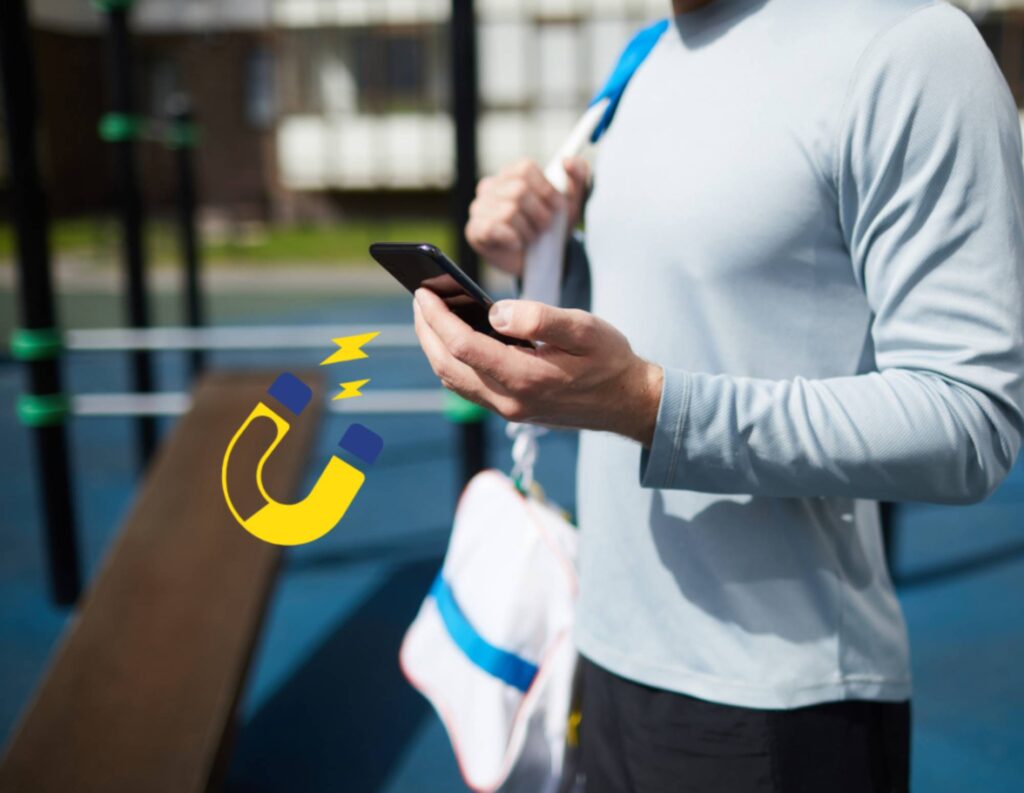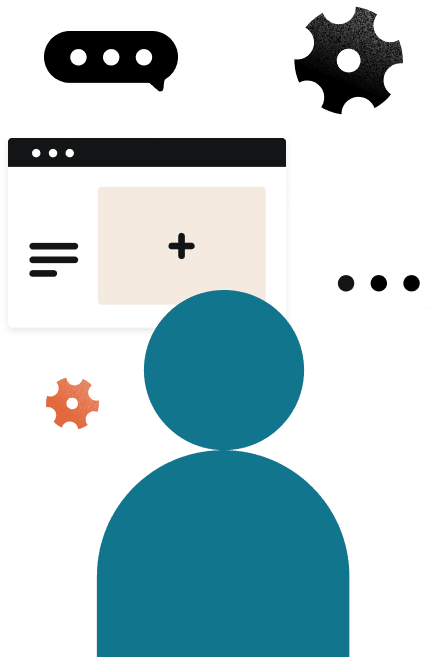Lead generation is a way to build interest in potential clients, helping you increase conversions. Learn how to generate leads and move them through a sales funnel to turn more leads to clients.

It’s frustrating to put heaps of time and money into marketing efforts only to see a small change in sales. People rarely convert on their first impression, but quite often the business leads that marketing generates wind up lost or ignored. This is a sign that your current strategy needs to incorporate lead generation and nurturing.
Leads are prospective clients who are interested in your company but are not yet ready to make a sale. Because they already have interest, they’re easier to convert into paying clients. But you need to make sure they stay interested until they’re ready to make a purchase. Keep reading to learn how you can generate business leads to help your business thrive.
📍Explore more on lead generation:
Capturing leads
Qualifying leads
- How to identify your ideal client
- How to evaluate customer fit in 6 steps
- How to evaluate qualified leads for your business
- How to use sales qualified leads
Tools and strategies
Jump to:
- Why are business leads important?
- Create a lead generation strategy
- How to attract high-quality leads
- Gather the right leads data and insights
- How to move leads through a sales funnel
- Nurture leads through email marketing
- Convert your leads to clients
Why are business leads important?
Most businesses lack the sales and client base they need to survive and grow without generating new leads. Plus, clients may decide at any time to stop buying your services, meaning you need to constantly expand your business lead list to maintain a consistent cash flow.
But business leads provide more than just a list of emails and phone numbers. Here are some other important benefits that generating and nurturing leads provides:
- Brand awareness: Since leads are interested in your business, they’re likely to refer people you may not have targeted to your services, expanding your market.
- Broader client base: Having more sales leads increases your recognition among your peers, opening you up to more partnership and investment opportunities.
- More possibilities to grow your business: You get sales leads by building relationships with prospective clients, which helps you retain clients for longer and allows you to conduct market research by asking them about their buying habits and preferences.
- Better client relationships: You spend less time and money to convert leads compared to new prospective clients since leads are already interested in purchasing your service.
Create a lead generation strategy across channels
Lead generation is the process of making yourself more visible, credible, and trustworthy to potential leads so that you can build interest.
To generate leads, you should take an omni-channel approach that engages with potential clients on each platform they use. For example, you can leverage lead generation in digital marketing through ads, SEO, and more. You can also use traditional sales tactics to generate leads, such as speaking at conferences and distributing your business card.
By using multiple channels, it allows you to reach leads with the method that’s most convenient to them. It also helps you from oversaturating any one channel with your content, which could turn them away.
Your lead generation strategy should be specific to your ideal client profile. A lead source, or the channel where a lead first discovers your business, plays a big part in that. Here are some that you should consider.
Social media ads
Facebook and Instagram ads are among the best ways to drive leads on social media. On Facebook, you can create campaigns with a “lead generation objective” that gives clients a contact form to fill out without leaving the platform. You can also set up a Facebook pixel on your ads to track lead conversion data.
Instagram and Facebook ads, along with Twitter ads, offer powerful targeting customization to reach very specific groups. On these platforms, you can create different ads to best appeal to potential leads in each segment of your target audience.

TikTok is a platform that has recently dominated other popular social media platforms, making it a great source of leads as well. With a TikTok business account, you can place an Instant Form in your fully customizable TikTok Lead Ads so that potential leads can share their contact information with you directly from the app. It also speeds the process along for users by pre-populating some basic information from their account profiles.
LinkedIn is another great platform where you can approach potential leads more directly since users already expect to discuss business on it. Many people use LinkedIn to learn about new tools, products, and approaches in their field, so they’re likely to become leads if you catch their interest with business education.
You could also generate leads by answering industry questions and posting on relevant platforms for your niche, like Stack Overflow and appropriate Reddit communities, approaching potential leads in places where they spend the most time online.
Content marketing and lead magnets
High-quality content helps you increase your website’s domain authority. It also nurtures leads by increasing brand loyalty, since people who find the content useful may start returning to your website to learn more.
For the best success in generating leads, align your content with a lead magnet. Think of options like ebooks, videos, or worksheets that expand on your article in a useful way for the reader. In exchange for it, they must give you their contact information. Lead magnets are a great method for email list building since you can ensure people signing up for your list are interested in your business topics.
However, people aren’t typically comfortable sharing their contact information, so you have to make the lead magnet feel like a fair exchange. It can help to let them know that you won’t spam them and will only send them useful information, but this isn’t enough. To make sure your lead magnet is effective, keep these criteria in mind:
- Helps solve a problem: The lead magnet needs to fix some pain point that the reader currently faces.
- Makes a short, simple, and specific offer: If your lead magnet is complicated, it’s more difficult to create a compelling offer for it that people will respond to. They’re more likely to interact with an offer that tells them exactly what they will get, in concise and precise terms.
- Has a single, clear focus: A lead magnet with a single focus lends itself to a strong offer. With only one focus, you can also ensure you solve a single problem better, rather than giving weaker solutions to multiple problems.
- Carries a high perceived value: To increase the perceived value of an offer, you need to make it feel exclusive, scarce, and in high demand. This is why limited-time and limited-quantity offers are possible — in fact, a recent HubSpot study found that an offer available for two days outperformed an offer that didn’t mention time by 8%.
- Provides value: Many lead magnets don’t actually give value after getting an email, which fosters a bad relationship between the brand and the lead. Rather than incentivizing subscribers with free updates, your lead magnet should include something like a free trial or webinar that gives them real value.
- Fits your target market: It should go without saying, but the leads you generate need to be interested in your services to convert. A content magnet that fits this segment of the population will help you attract leads who are more likely to become clients.
- Delivers immediate benefits: People are most likely to find a lead magnet useful if it gives them an immediate solution, rather than something in the future. For instance, if the magnet is trying to help people lose weight, it could be a list of exercises they can do right now at home.
- Is simple to consume: No one wants to download something to solve a problem and then find it difficult to go through — like a long-form document or a dry, complicated report. Ideally, your lead magnet shouldn’t take more than 10 minutes to consume, so it doesn’t feel like it takes time out of someone’s day.
- Has an attractive design: Remember to consider design elements in your content magnet. If it looks more professional, with brand colors, fonts, and style, it will feel like a more valuable offering.
How to attract high-quality leads
High-quality leads, or qualified leads, are prospects who are very likely to convert — they’re more informed about your services and they’re ready to make a purchase. It’s best to focus on attracting leads who are closer to your ideal client rather than spending valuable time and energy on an approach to a wider audience.
Here are some ways you can generate more high-quality leads.
Map your ideal buyer profile
To make sure you target clients who are most likely to convert, you should first determine what your ideal client looks like. You could modify a profile available online or make one yourself. To make one, you simply need to list the behavior and qualities you want to see from someone buying your service.
Some profile attributes you should consider include:
- Demographic attributes: These are factors about the segments of the population that your client belongs to, like their age, location, and job title
- Firmographic attributes: This is information related to the company, like location, current client base, and revenue
- Technographic attributes: These relate to the client’s technological ability, like the technologies they use
For behavior, consider how prospects interact with your content, such as the frequency of site visits, number of visits, and engagement with social media posts or emails.
Try to be specific. Who is your ideal client, what problems do they face, and why are they seeking your services? Answering these questions better will help you tailor your marketing efforts to your ideal persona and evaluate them for the best customer fit.
Identify the most effective content types and channels
The content types and channels that you use will depend on your ideal buyer persona. You should be making content that they would want to consume and placing it in channels that they visit. For instance, if your ideal buyer fits a younger demographic, you might reach more of your target audience with short promotional videos on TikTok than with a long email.
You should also look at the content pieces that have been a part of the journey for leads who became clients previously. These pieces were touchpoints that convinced the client of your value, so you should analyze them to figure out why they were effective and what elements you can incorporate into future content.
Pro tip
83% of marketers believe it’s more important to make the highest-quality content possible, even if it means posting less often. Many platforms’ algorithms show users content similar to posts they usually interact with, so the best way to stay visible to your target market is to create content that they will engage with.
Make it easy for leads to provide their information
When the process for providing information is simple and clear, you make it more likely that people fitting your ideal client profile will become leads. This is why most businesses integrate contact forms on their website.
Reducing friction and minimizing steps for potential leads lowers the chance of abandonment. Don’t overwhelm them by asking for too much information — all you typically need is their name and email address. Taking an omni-channel approach by adding your contact form links on your social media accounts helps too. People can join your email leads from whatever channel they find you on.
Also, make sure to review your CTA to ensure it communicates your value clearly and avoids common contact form mistakes. Users should always understand what they’re signing up for.
Gather the right leads data and insights
If you want to increase your qualified leads, you should make sure you’re gathering the right data to focus on reaching them. The metrics you track from your analytics should reflect the quality of your leads, such as:
Zero-party data
Zero-party data is a fancy term for data that leads provide about themselves. The best way to gather these insights is through questionnaires that you send directly to them. As soon as a lead inquires on your website, you can trigger a questionnaire that asks a series of background questions.
You can keep it simple, but ask for information like their budget and timeline. These are some of the biggest factors that can determine whether or not they’ll purchase your services, so gathering these insights as early as possible will be important for your workflow.
First-party data
First-party data is data about your leads, but they may not offer it directly to you. Instead, you can get it from looking at their behavior on your website (using tools like Google Analytics), or how they engage with your email marketing.
- Visitor to leads: This tells you how many visitors to your landing pages or other digital touchpoints become qualified leads
- Leads to opportunities: This shows the number of inquiries that become sales-qualified leads, or prospective clients who are ready to make a purchase
- Time to conversions: This shows the time and marketing efforts it took to turn a lead into a sale
Third-party data
You can also collect buyer intent data, which is a collection of behavioral signals you can use to identify qualified leads, like high engagement with your content. In fact, according to a recent survey, buyer intent data can help you see 47% higher conversion rates and close 38% more deals.
Buyer intent data comes from third-party sources like:
- Social media data
- Content consumption data
- Website data
- Off-site activity, like product reviews or posts on forums or message boards
Pro tip
With HoneyBook, you can capture lead data and qualify them faster with AI capabilities. Get notified when you have a lead who’s more likely to book and/or a lead with a higher budget!
How to move leads through a sales funnel
A lead generation funnel helps you visualize a prospect’s journey from first discovering you until they become a client. In an effective funnel, leads enter the client journey at the top, descend to the middle as they become more interested, and finally reach the bottom, where they’re ready to make a purchase.
You should make different content for each stage to help move the prospect along the funnel and avoid abandonment. Here is a deeper look at how content differs at each stage:
- Top-of-funnel (TOFU) content: This content aims to build brand awareness. You can use tactics like SEO and paid advertising in conjunction with your ideal client personas to optimize capturing the attention of ideal clients. This is also where you collect contact information, so you can move the lead to the next stage.
- Middle-of-funnel (MOFU) content: Here, you nurture leads who are interested but not yet ready to make a purchase. You should use their contact information to regularly send them useful informational content, like white papers and case studies.
- Bottom-of-funnel (BOFU) content: At this stage, the client is ready to make a purchase. Your content should help them convert, offering a free trial or sending a discount code for an abandoned cart.
To build your own lead generation funnel, follow these 7 steps:
- Define your target audience: These are the people who you will try to turn into leads. Your ideal buyer persona should fit this audience.
- Identify a problem that your target audience struggles with: Spend time in the online spaces where your target audience hangs out and pay attention to discussions going on. Try to find a problem that your front-end offer — the first product you’ll offer — can solve for them.
- Create a lead magnet that solves their problem: Try to pick the best format for your message. For instance, if you notice that some relevant Facebook groups have many posts about wanting to learn a certain skill, your magnet could be a video or cheat sheet that teaches it.
- Make a landing page for the lead magnet: This is the page where you will ask for the prospective client’s contact information. You can raise your chance of getting a sign-up if your page includes strong sales copy, a CTA button, and some form of social proof if possible.
- Set up automatic emails to nurture the lead: Automatic emails help you communicate with a lead quickly. In a sequence of emails, you should give the prospect some value, warm them to the idea of buying your front-end offer, and make a sales pitch for the offer. Make sure you find the right balance between selling your product and providing value.
- Drive traffic to the lead magnet landing page: Now, you’re ready to drive traffic to the landing page. The fastest way is usually with paid advertising on Facebook or Instagram, though SEO may be a useful long-term strategy to generate traffic, so you can eventually stop relying on paid ads.
- Analyze your results: Take a look at metrics like ad conversion rates, landing page conversion rate, and lead-to-client conversion rate, along with any feedback you get from people who downloaded your lead magnet. Then, you can start experimenting with ideas to improve your funnel.
Nurturing leads through email marketing
Once you have your email list of leads, you need to nurture them until they’re ready to make a purchase. With an ROI of $36 for every $1 spent according to a Litmus survey, email marketing is a great way to do this.
Email marketing content is generally MOFU content, meaning it’s informational or promotional. It may aim to solve leads’ problems or teach them more about the field, building trust in your brand.
When you design your emails, there are a few copywriting and design elements to keep in mind, including:
- Subject line: Leads will decide if they want to read your email based on the subject line. That being said, you should spend some time devising ways to make your subject line more enticing. For example, it could address a problem your lead faces or call the lead to take an action, like downloading an ebook or attending a webinar.
- Conciseness: Think of how many emails you receive every day. Your leads likely get just as many. To make sure they keep opening yours, your emails should be brief and engaging.
- Images and graphics: Visual elements are easy to absorb and interesting to look at, which makes them a valuable tool in email marketing. Using images to reinforce and expand on your copy can help make your content more engaging and deliver your message more quickly.
- Social media integration: Readers who find your emails interesting may want to share them with friends or colleagues on a different platform. This is an opportunity to find new leads in an untapped audience. By including social media sharing links for different social media platforms, you let leads interact further with your content and generate earned media for you.
- Call to action: A CTA tells the lead what action you want them to take after reading your email. If your aim is lead nurturing, this can direct them to an ebook or webinar that will teach them more about the topic. Or, if you’re trying to sell a particular service, you can tell them how it will help solve their problem. Use action words like “attend,” “download,” and “try now” to urge them to take action without being too pushy.
Email marketing is also useful for BOFU content, for instance as loyalty program emails that offer users more rewards for making a purchase. It’s also useful in the form of cart abandonment emails that urge people to remain in the funnel in case they change their minds just before a purchase.
Convert your leads to clients
Once you’ve made it to the end of your relationship with a qualified lead, it’s time to convert them into a client. After all the work you’ve put into capturing, evaluating, and nurturing them, don’t let this part of the process slack!
Offer a seamless booking experience with a tool like HoneyBook. As soon as you have the green light, you can send an interactive file that combines your brochure of services with a contract and invoice. All in one step, leads can select their services and turn into new clients.
Better yet, HoneyBook lets you capture, nurture, and convert your leads all in one place. You can use HoneyBook lead forms to capture leads directly from your public channels and allow them to schedule, book, and, pay–all without your involvement. Better yet, all of HoneyBook’s tools are customizable, so you can customize your forms to fit your exact needs.







